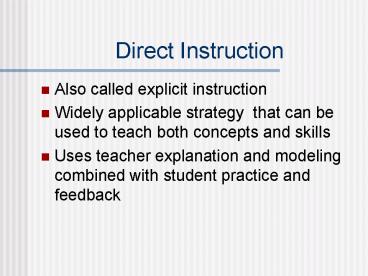Direct Instruction - PowerPoint PPT Presentation
Title:
Direct Instruction
Description:
... illustrates content. Models ... Social Cognitive Theory (Bandura) effectiveness of modeling on learning skills ... New content is presented and explained ... – PowerPoint PPT presentation
Number of Views:34
Avg rating:3.0/5.0
Title: Direct Instruction
1
Direct Instruction
- Also called explicit instruction
- Widely applicable strategy that can be used to
teach both concepts and skills - Uses teacher explanation and modeling combined
with student practice and feedback
2
Teacher Role
- Specifies learning objectives
- procedural skills automaticity transfer
- Explains and illustrates content
- Models skills
3
Student Role
- Active in responding to teacher questions
- Analyzing examples
- Practicing skills to mastery
4
Theoretical Foundations
- Teacher effectiveness research
- Social Cognitive Theory (Bandura)
- effectiveness of modeling on learning skills
- The influence of interaction on learning
(Vygotsky)
5
Teacher Effectiveness Research
- Teachers can increase student achievement by
- Using time well
- Presenting high quality examples
- Using clear language
- Providing effective feedback
- Questioning students
6
Direct Instruction Defined
- DI is academically focused, teacher-directed
instruction that uses sequenced and structured
materials - Goals are clear to students
- Coverage of content is extensive
- Performance of students is monitored
- Feedback is immediate
7
Characteristics of Direct Instruction
- Reviewing the previous days work
- Presenting new material in clear and logical
steps - Providing guided practice
- Giving feedback with correctives
- Providing independent practice
- Reviewing to consolidate learning
8
Social Cognitive Theory
- Bandura (1989, 1997)
- Learning by observing the behavior of others
- Central to theory is MODELING of the desired
behavior for students - Direct Instruction incorporates the benefits of
modeling into lesson design
9
Social Cognitive Theory
- Vygotsky (1978)
- Verbal interaction (language) helps students
learn - Direct Instruction is effective because it
adopted two concepts from the work of Vygotsky
10
Social Cognitive Theory Cont.
- First concept--SCAFFOLDING
- Scaffolding is the instructional support teachers
provide as students learn - Breaking skills into subskills
- Asking questions, with increasing difficulty
level - Modeling the steps
- Presenting examples
- Providing prompts and cues
11
Social Cognitive Theory Cont.
- Second concept--ZONE OF PROXIMAL DEVELOPMENT
(ZPD) - State of learning in which a student cannot solve
a problem or perform a skill alone and needs the
help of a teacher - Outside of ZPD, students either dont need any
help or lack the prerequisite skills or
background knowledge
12
Planning Lessons using DI
- Four steps
- Identifying topics (concepts and procedural
skills - Specifying objectives (automaticity and transfer)
- Identifying prerequisite knowledge
- Selecting problems and examples
13
Implementing Lessons with DI
- Phase 1 Introduction and review
- Students are drawn into the lesson
- Teacher attracts students attention
- Teacher activates background knowledge through a
thorough review of prerequisite knowledge or
skills
14
Implementing Lessons with DI
- Phase 2 Presentation
- New content is presented and explained
- Teacher begins schema production by explaining
and illustrating the concept or explaining and
modeling the skill being taught - Teacher promotes involvement by modeling,
providing examples, and actively questioning
students to guide their understanding
15
Implementing Lessons with DI
- Phase 3--Guided practice
- Students practice the concept or skill under the
teachers guidance with high levels of
interaction - Teacher helps students develop perceptions of
competence - Teacher ensures success
- Teacher monitors progress
- Role of teacher changes. Teacher moves from
information provider and modeler to COACH,
withdrawing instructional support as students
master skill.
16
Implementing Lessons with DI
- Phase 4--Independent practice
- Students practice using the concept or skill on
their own - Students develop automaticity
- Students develop the ability to transfer their
understanding to new contexts - Two stages (1) students practice on their own
under teacher supervision and (2) students work
on their own on a homework assignment
17
Increasing Motivation with DI
- The guided practice of DI develops perceptions of
competence. Perception of competence is highly
motivating. As students become more competent in
using the concept or skill, they equate their
hard work with success.
18
Applications of DI
- Direct Instruction can be used to teach
generalizations, principles and rules. - (We will discuss generalization, principles and
rules later in the semester)
19
DI and Diverse Learners
- DI has been shown to be especially effective with
learners from diverse backgrounds - Explicit approach to teaching (with modeling)
- Interactive nature, constant monitoring
- Structured approach, extensive practice
- All contribute to greater success for diverse
learners































